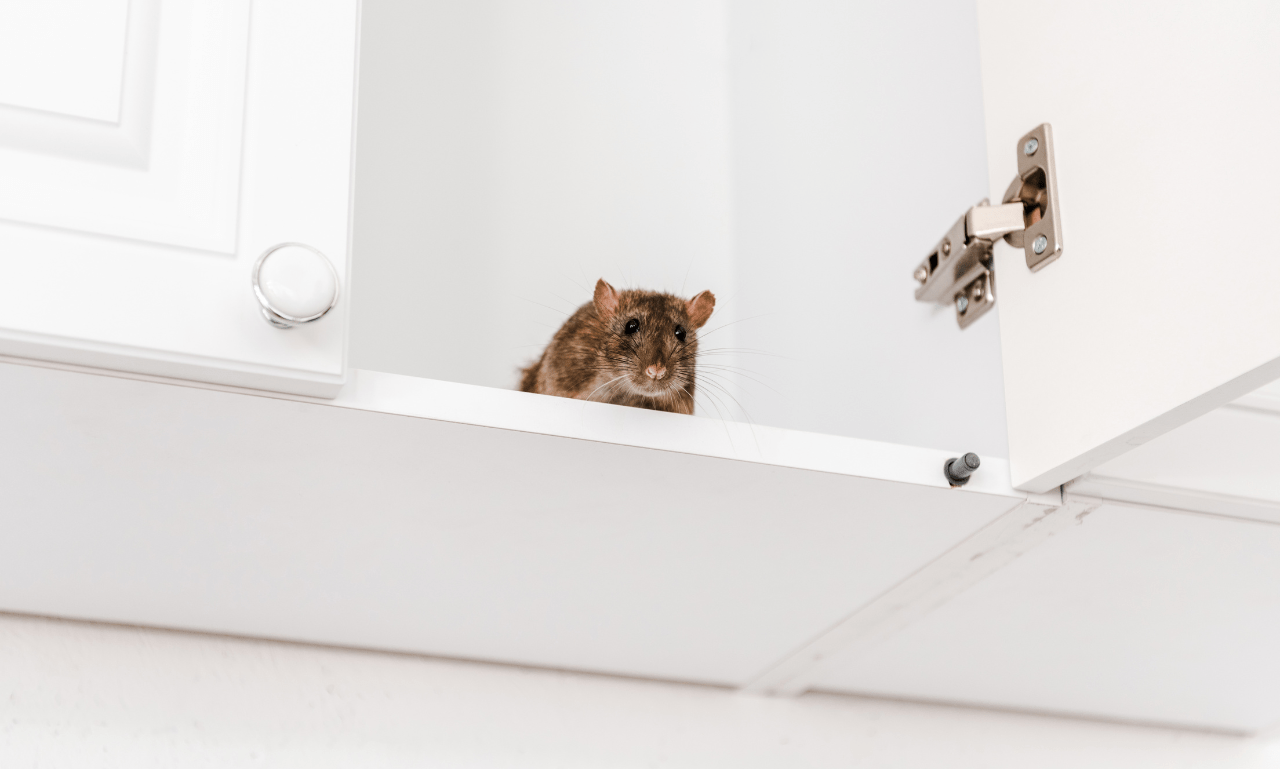Introduction
Mice in your cabinets can be a homeowner’s nightmare. These small rodents are known for their ability to infiltrate even the tiniest openings and wreak havoc on your kitchen and pantry. In this comprehensive guide, we will delve into the intriguing question, “Can mice open cabinets?” Understanding the behavior of mice in your home is crucial for effectively preventing and addressing this issue.
Mice are not merely pests; they’re resourceful creatures with an uncanny ability to adapt to their environment. While it might seem unlikely that mice can open cabinets, homeowners have reported instances that suggest otherwise. This article aims to shed light on whether mice truly possess this capability, providing you with valuable insights into their behavior.

Understanding the Behavior of Mouse
To comprehend how mice interact with your cabinets, it’s essential to delve into their behavior within a household setting. Mice are naturally curious creatures, driven by their keen sense of smell and insatiable hunger. They’re skilled climbers and can easily access cabinets via walls, pipes, or even electrical wires. Once inside, their agility and determination come into play.
Mice in search of food and shelter are likely to explore your kitchen, making cabinets an attractive target. They are known for their nocturnal habits, typically venturing out at night when the house is quiet. Their small size allows them to navigate through narrow gaps and openings, making it seem like they can magically access your cabinets.

Signs of Mice in Cabinets
Detecting the presence of mice in your cabinets is crucial for prompt action. While it might not be immediately evident whether they can open cabinets, certain signs can confirm their presence. These signs include droppings, gnawed packaging, chewed wires, and even the distinct odor of mouse urine. By recognizing these indicators, you can act swiftly to address the issue and prevent further infestation.
Early detection is essential to minimize the damage and health risks associated with mice in your cabinets. Ignoring these signs can lead to a full-blown infestation, which is more challenging and costly to eradicate. In the following sections, we’ll explore preventive measures, strategies for dealing with an infestation, and practical solutions for keeping your cabinets mouse-free.

Can Mice Really Open Cabinets?
Instances where it seems like mice have opened cabinets are often the result of a sequence of events. For example, a mouse might initially find a small gap or opening in a cabinet, such as a loose or damaged panel. Over time, the mouse’s natural gnawing tendencies can enlarge this gap, making it appear as though the cabinet door was opened from the outside.
Mice possess sharp claws and strong teeth, which enable them to gnaw through various materials, including wood and plastic. However, opening a cabinet door involves a different level of complexity. Typically, cabinet doors are designed to be opened by humans, requiring a grasp or a push-and-pull motion.
Another scenario involves mice taking advantage of poorly closed cabinet doors. If a door is not securely shut and there is food or an enticing scent inside, a mouse may push or squeeze its way inside, causing the door to move slightly ajar. This can create the illusion that the mouse intentionally opened the cabinet.
In short, while mice do not have the capability to intentionally open cabinet doors like humans, their resourcefulness and persistence can lead to situations where it appears as though they’ve accessed cabinets. Understanding this distinction is essential when addressing a mouse infestation in your home.

Prevention and Protection Strategies
Preventing mice from entering your cabinets is the most effective approach to dealing with this issue. By implementing a range of proactive measures, you can safeguard your kitchen and pantry from these unwanted visitors. Here, we’ll provide you with practical tips and strategies for keeping mice out of your cabinets and ensuring a mouse-free home.
- Sealing Entry Points: Begin by inspecting your kitchen for potential entry points. Seal any cracks, gaps, or holes in the walls, floors, or cabinet bases. Mice can fit through incredibly small openings, so even the tiniest gaps should not be overlooked.
- Secure Food Storage: Store food items in airtight containers made of glass or metal. Mice are drawn to the scent of food, and improperly sealed packaging can be an open invitation to explore your cabinets.
- Regular Cleaning: Maintain a clean and clutter-free kitchen. Remove food crumbs and spills promptly, as these can attract mice. Regularly clean and disinfect your cabinets to eliminate any lingering odors that might entice rodents.
- Use Mouse-Repellent Materials: Consider placing mouse-repellent materials in and around your cabinets. These can include natural deterrents like peppermint oil-soaked cotton balls or commercial products designed to repel rodents.
- Traps and Baits: Set up traps and bait stations strategically in areas where you suspect mouse activity. Snap traps, electronic traps, and humane catch-and-release traps are options to consider.
- Maintain Outdoor Areas: Ensure that the exterior of your home is mouse-proof as well. Trim overgrown vegetation and eliminate potential hiding spots around the house.
By implementing these preventive measures, you can significantly reduce the likelihood of mice accessing your cabinets and help protect your home from infestations.

Dealing with a Mouse Infestation
Discovering mice in your cabinets can be distressing, but there are steps you can take to address the issue promptly and effectively. It’s crucial to act swiftly to prevent the infestation from spreading further and causing more significant damage.
- Identify the Extent: Begin by assessing the scale of the infestation. Determine how many mice are present and where they are most active. Pay close attention to cabinet areas with signs of infestation.
- Safe Removal: If you prefer a humane approach, consider using catch-and-release traps to capture mice alive. Alternatively, snap traps and electronic traps can also be effective for quick and humane removal.
- Dispose of Captured Mice: When using live traps, release captured mice at least a mile away from your home to prevent their return. For other traps, follow appropriate disposal methods.
- Sanitation: Thoroughly clean and disinfect your cabinets and surrounding areas. Remove any contaminated food items and clean dishes, utensils, and cookware that may have been exposed to mice.
- Ongoing Vigilance: Continue monitoring your cabinets and implementing preventive measures to avoid future infestations. Regularly inspect your home for signs of mouse activity.
Addressing a mouse infestation requires diligence and persistence. While DIY methods can be effective for small infestations, more extensive or recurring problems may necessitate professional pest control services.

DIY Solutions and Products
For homeowners who prefer a hands-on approach, there are various do-it-yourself (DIY) solutions and products that can help deter mice from your cabinets and prevent infestations. These DIY methods are often cost-effective and environmentally friendly.
- Peppermint Oil: Peppermint oil is a natural mouse repellent. Soak cotton balls in peppermint oil and place them strategically in and around your cabinets to create a strong scent barrier that mice find unpleasant.
- Steel Wool: Seal gaps and openings in your cabinets with steel wool. Mice cannot gnaw through this material, making it an effective barrier.
- Ultrasonic Repellent Devices: Ultrasonic repellent devices emit high-frequency sounds that are unpleasant for mice but safe for humans and pets. These devices can deter mice from entering your cabinets.
- Homemade Traps: You can create DIY mouse traps using common household items, such as cardboard tubes, buckets, or bottles. These traps can be effective for catching mice.
- Cleanliness: Regularly clean and sanitize your cabinets, removing any food residue or crumbs that might attract mice.
While DIY solutions can be helpful, it’s essential to remember that they may not be as reliable as professional pest control services, especially for severe infestations. Depending on the scale of the problem, you may need to consider a combination of DIY methods and professional assistance.

Professional Help and When to Seek It
In some cases, dealing with a mouse infestation may require the expertise of pest control professionals. Here are instances when it’s advisable to seek professional assistance:
- Severe Infestations: If you have a large-scale mouse infestation that DIY methods have failed to control, it’s time to call in the experts. Professionals have the knowledge, experience, and resources to tackle extensive infestations effectively.
- Recurring Infestations: If mice keep coming back despite your efforts to eliminate them, it may indicate a deeper issue that professionals can identify and address.
- Health Concerns: If you have concerns about the health risks associated with mouse infestations, such as the spread of diseases or contamination of food and surfaces, it’s crucial to involve professionals who can implement safe and effective solutions.
- Structural Damage: Mice infestations can cause damage to your home’s structure, wiring, and insulation. Pest control professionals can assess and address these issues.
- Peace of Mind: If you want the peace of mind that comes with a thorough and comprehensive solution, professional pest control services can provide ongoing monitoring and preventive measures.
When seeking professional pest control services, choose a reputable and licensed provider with a track record of effectively addressing mouse infestations. They will tailor their approach to your specific situation and ensure that your home remains mouse-free.

Keeping Your Home Mice-Free
Maintaining a mouse-free home requires ongoing vigilance and the implementation of preventive measures. By following the strategies outlined in this guide, you can significantly reduce the
likelihood of mice returning to your cabinets and invading your home Here’s a brief summary of the key takeaways:
- Regular Inspection: Periodically inspect your cabinets, kitchen, and surrounding areas for signs of mouse activity. Early detection can prevent infestations from escalating.
- Sealing Entry Points: Continuously check for and seal any potential entry points, including gaps, cracks, and holes, to keep mice out.
- Proper Food Storage: Store food items in airtight containers made of glass or metal to minimize the scent of food that may attract mice.
- Cleanliness: Maintain a clean and clutter-free kitchen. Promptly clean up spills and crumbs, and regularly disinfect your cabinets.
- DIY Solutions: Consider using DIY mouse repellent methods, such as peppermint oil or steel wool, to deter mice from entering your cabinets.
- Professional Assistance: If you experience recurring or severe infestations, or if you have concerns about the health or structural integrity of your home, seek professional pest control services.
By implementing these practices consistently and staying vigilant, you can protect your home from mouse infestations and enjoy a clean and pest-free living environment.
Conclusion
In conclusion, understanding the behavior of mice in your home, their limitations, and their resourcefulness can help you effectively address and prevent infestations in your cabinets. While mice may not possess the ability to intentionally open cabinet doors like humans, their persistence and adaptability can create situations that appear otherwise.
By following the prevention and protection strategies outlined in this guide, you can maintain a mouse-free home. Regular inspections, proper food storage, and diligent cleanliness are your allies in this ongoing battle against unwanted rodent guests. Should you encounter a severe or recurring infestation, don’t hesitate to seek professional pest control services for a comprehensive solution and peace of mind in your mouse-free home. Remember, a proactive approach is key to safeguarding your cabinets and your home from these persistent intruders.
For more tips on pest control and keeping unwanted visitors like lizards out of your garage, check out our comprehensive guide, ‘HOW TO KEEP LIZARDS OUT OF YOUR GARAGE: A COMPREHENSIVE GUIDE’.















